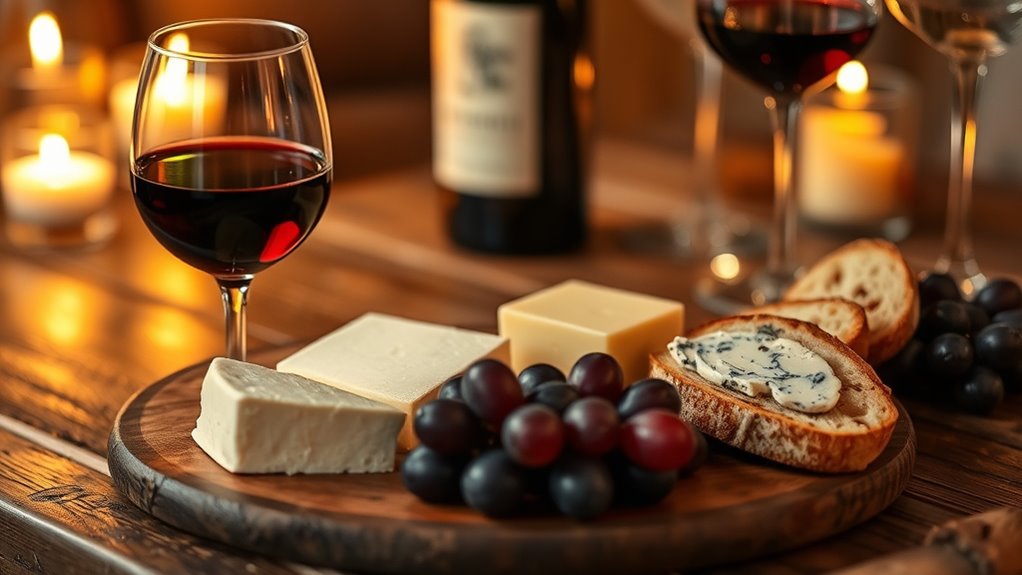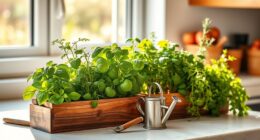For a cozy wine and cheese tasting for two, start by selecting cheeses with different textures and flavors, like Brie and aged Cheddar, and pair them with wines such as Sauvignon Blanc or Cabernet. Arrange everything neatly, label each item, and begin with lighter flavors, progressing to bolder ones. Use neutral palate cleansers and engage your senses to explore aromas and textures. Want to craft a memorable and balanced experience? If you keep going, you’ll discover even more ideas to impress your guest.
Key Takeaways
- Select a variety of cheeses with different textures and flavors to create interest and balance with your wines.
- Arrange cheeses and wines from light to bold to enhance the tasting experience.
- Label each pairing to guide your partner and highlight flavor combinations.
- Use neutral palate cleansers like crackers or bread between tastings to refresh your palate.
- Maintain a relaxed atmosphere, encouraging sharing impressions and discovering new favorite pairings.

Pairing wine with cheese can elevate your tasting experience, turning a simple snack into a sophisticated delight. When you focus on wine and cheese pairings, you *unveil* a world of flavor combinations that can impress your guest and enrich your palate. The key is balancing the textures and flavors, so each sip and bite complements the other perfectly. A well-thought-out tasting presentation doesn’t just showcase the cheeses and wines but also guides your senses through a harmonious journey. You want to create an inviting atmosphere where each pairing feels intentional, enhancing the overall experience.
Start by selecting a variety of cheeses that differ in texture and flavor profile—perhaps a creamy Brie, a sharp Cheddar, a tangy Blue, and a nutty Gruyère. This diversity provides a broad spectrum of tasting notes, making your pairing session more engaging. For wines, choose a few styles that complement or contrast with your cheeses. A crisp Sauvignon Blanc pairs nicely with goat cheese, while a rich Cabernet Sauvignon can stand up to aged Cheddar. Don’t forget to include a sparkling wine or a light rosé to add versatility and brightness to your tasting presentation. Your goal is to create a flow that guides your guest from light to bold, or from mild to intense, helping them appreciate each pairing’s nuances.
When presenting your wine and cheese selections, arrange everything neatly on a platter or a dedicated tasting board. Label each cheese and wine to help your guest identify each pairing and understand the thought behind your choices. Use small tasting glasses and cheese knives to maintain a clean, elegant setup. As you introduce each pairing, encourage your guest to observe the aroma, texture, and flavor before taking a sip or bite. Suggest starting with a neutral palate cleanser, like plain crackers or bread, to reset taste buds between samples. This helps highlight the unique qualities of each pairing and keeps the tasting presentation fresh and enjoyable.
During the tasting, engage your guest by asking questions about what they notice—the creaminess, acidity, or boldness—and guide them to explore the contrasts and complements. Remind them that there’s no right or wrong; the goal is to enjoy and discover new favorites. Keep the mood relaxed and conversational, allowing the flavors to unfold naturally. Incorporating proper storage techniques for your wines and cheeses can also ensure freshness and optimal tasting quality. With careful selection, thoughtful presentation, and an inviting atmosphere, your wine and cheese pairing session becomes a memorable experience for two, turning a simple evening into a celebration of taste and connection.
Frequently Asked Questions
How Do I Properly Serve Wine and Cheese for a Tasting?
To serve wine and cheese properly, start by selecting the right glassware, like a tulip-shaped glass for reds or whites. Make sure your wine is at the proper serving temperature—chilled for whites and slightly below room temperature for reds. Arrange the cheese attractively, offering a variety of textures. Pour the wine gently into the glass, allowing your guest to appreciate the aroma before tasting. This creates an enjoyable tasting experience.
What Are Common Mistakes to Avoid When Pairing Wine and Cheese?
Imagine savoring a perfect bite, but an overpowering cheese overwhelms your palate or the wine feels too warm, dulling its vibrant notes. Avoid common mistakes like ignoring poor temperature control, which can mute flavors, and pairing cheeses with overpowering flavors that clash rather than complement. Serve cheese at room temperature and select wines that enhance rather than compete, creating a harmonious tasting experience for you and your partner.
How Can I Tell if a Wine or Cheese Is Spoiled?
You can tell if wine or cheese is spoiled by checking their shelf life and spoilage indicators. For wine, look for a sour smell, off taste, or cloudy appearance, which suggest spoilage. For cheese, watch for mold that isn’t typical, a sour or ammonia smell, or a slimy texture. If any of these signs appear, it’s best to discard them to avoid unpleasant surprises.
Are There Budget-Friendly Options for a Quality Tasting?
Yes, you can enjoy a quality tasting with affordable selections. Look for budget-friendly tips like choosing versatile wines such as Pinot Noir or Chardonnay, which are often more affordable yet flavorful. Visit local stores for deals on cheese varieties like cheddar or gouda, and consider buying in larger blocks for better prices. You don’t need expensive options—smart choices and shop sales to create an enjoyable, budget-friendly tasting experience.
How Do I Accommodate Allergies or Dietary Restrictions?
Imagine your tasting as a carefully curated garden; you can still create beauty despite obstacles. To accommodate allergies or dietary restrictions, choose gluten-free cheeses and vegan wine options, ensuring everyone feels included. Be transparent about ingredients, and offer a variety of safe options. This thoughtful approach lets your guest enjoy the experience fully, showing that with a little extra care, you can craft a delightful, inclusive tasting for two.
Conclusion
Imagine hosting your own tasting, where each sip and bite tells a story. I once paired a bold Cabernet with creamy Brie, and the harmony reminded me that good pairings are like conversations—balanced, surprising, and memorable. Just like a well-told story, your wine and cheese choices create an experience worth savoring. Trust your instincts, experiment, and enjoy the journey—after all, the best moments often come from the unexpected. Cheers to your perfect pairing!








